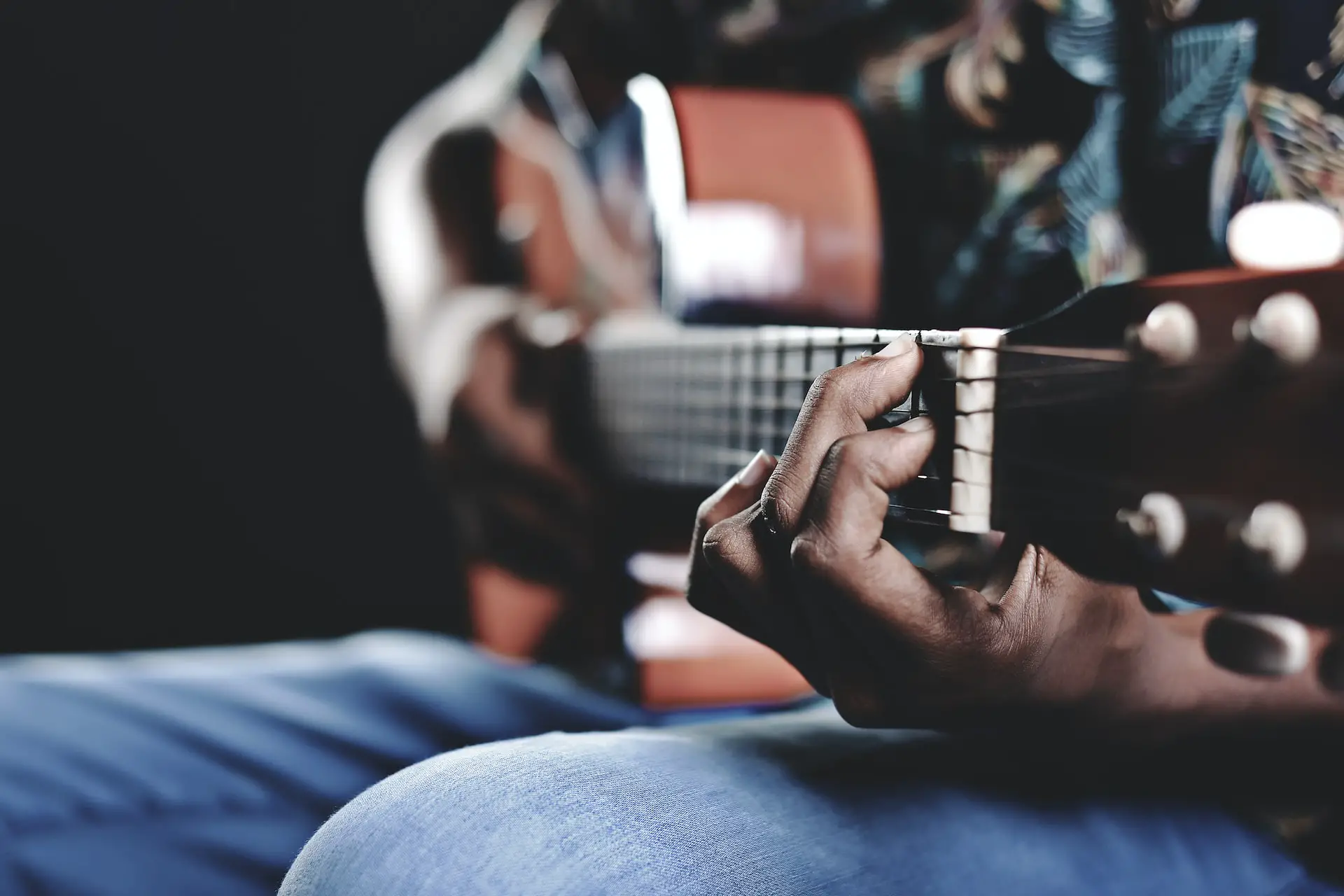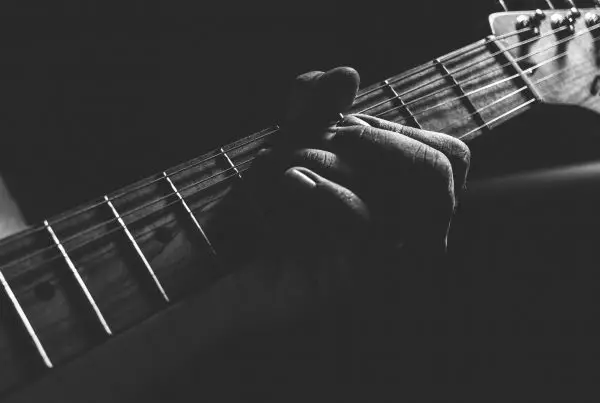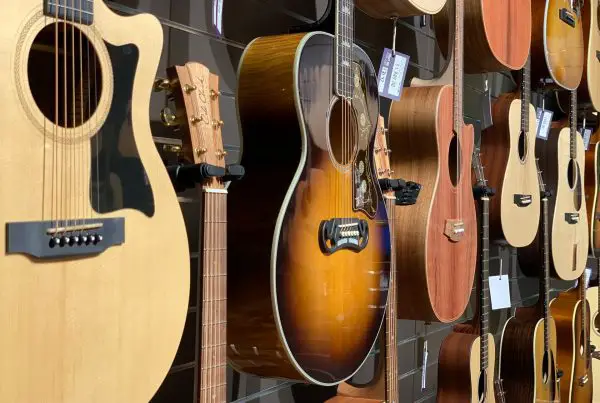No one enjoys purchasing an instrument and not having to enjoy it for quite a while before it starts giving issues.
Most importantly, even if these problems are certain to arise at some point, we still wouldn’t want to be uninformed of the steps to take to ensure that we continue to enjoy our instruments at all costs. Is your guitar warped? Hey, something can be done!
A warped guitar neck indicates that the neck is no longer straight. Numerous factors, including humidity, temperature variations, string tension, and even the construction of the guitar itself, can contribute to guitar warping.
However, by carefully caring for your guitar, storing it in cases constantly to avoid significant heat and humidity changes, loosening your strings, and following some other guidelines, you can avoid prevent warped necks.
Follow along as I explain what causes guitar warping, how to prevent your guitar from warping and, if your guitar is warped already, how to repair or straighten it.
5 Causes & Prevention For Guitar Warping
A guitar is a very delicate instrument. Taking proper care of it by avoiding the issues listed below, you would be less likely to have a warped neck.

Guitar is a sensitive instrument which requires immense care
1. Continuous Exposure To Heat
Guitars are composed of wood, hence heat is a primary cause of warping. This happens when your instrument is subjected to intense, direct sunshine or heat. It is always dangerous since the heat can lead to bending, breaking, and the separation of bonded joints. All of which have the potential to harm your guitar permanently.
Here are some guidelines you may follow to make sure your instrument is shielded from heat:
- Keep Your Guitar Out of Direct Sunlight. Keep your guitar out of direct sunlight since overstretched strings might cause it to go out of tune while you’re playing.
- Keep Your Instrument Out of the Trunk. The temperature in the trunk of your automobile may be up to 60 degrees hotter than the outside. Numerous problems, including loose bridges, misaligned necks, fret heave, and warping, can be brought on by a brief stay in the trunk.
- Keep your guitar away from any device that produces heat. Remembered that always keep your guitar away from any kind of devices that creates or produces heat.
2. Changing Humidity
For a perfect condition, you should establish a relative humidity between 44 and 55 per cent to protect the condition of your instrument. Tone wood can suffer negative impacts from excessive or insufficient humidity levels.
Failure to keep your guitar’s moisture at ideal levels can lead to a variety of problems, including protruding frets, wood cracking, fret buzz, a sunken top, neck bending and warping, and the bridge on an acoustic guitar may even lift. These problems will have a significant impact on your guitar’s tone and playability.
Here are some suggestions for shielding your acoustic guitar from the dangers of low humidity.
- Use humidifiers: The right approach to humidifying entails adequately humidifying both the room and the guitar case holding the instrument.
- Use a humidity reader inside the case: A frequent error is to solely maintain a humidity reader in the room. You must also be certain of the humidity levels inside your guitar box. This is why a humidity reader must be kept in every guitar case that contains an acoustic instrument.
- Keep the guitar cases closed: When you open the case of your guitar, you expose it not just to dry air but also to the destruction of the humid environment that has been building up inside the case over time. This then makes it crucial to keep the acoustic guitar in its case for as long as feasible.
3. Ageing Guitar
When a guitar ages, it begins to warp. A vintage guitar from a few decades ago is unquestionably regarded as a collector’s treasure, but its age might ruin its condition. Not every wood will withstand aging well. Guitar neck warping can be caused by aged or weak wood.
For this reason, many players decide to buy or change their instrument once they have been playing continuously for two or more years.
4. Natural Tension From Strings
The natural tension from the strings is another factor that causes warping. Your guitar’s condition over time will unquestionably depend on how tightly you have the strings wound. When the strings are overly tight, they draw up on the neck of your guitar and put pressure on it.
The pressure gradually warps the neck, throwing it out of alignment. To relieve the pressure from the strings on the neck when you complete playing, tune your guitar or adjust the string tension to a half- or full-step lower.
5. Poor Manufacturing
A guitar neck may be more prone to warping if it is not built or constructed properly. This is why it’s crucial to purchase a high-quality guitar from a reputable guitar brand.
How To Fix Warped Guitar?
To fix a guitar neck that is warped, just follow these easy steps:
- Use the steam from an iron to help you remove all the frets.
- Next, remove the fretboard with a hammer and scraper.
- Using tension rods and wood, construct a straightening jig.
- As you connect the A and B tuning pegs to the tension rods, make any necessary changes to the pegs.
- To strengthen the neck’s newfound straightness, apply heat.
- Reinstall the fretboard using glue.
- Change your guitar’s strings.
If the warping is only slight, you might be able to correct it by adjusting the truss rod as I have described in the steps above. The truss rod is the metal rod that runs along the inside of the guitar neck and is used to adjust the tension of the strings. But, if the warping is more severe, you might need to have the guitar neck replaced by a skilled luthier.
Cost To Fix a Warped Guitar
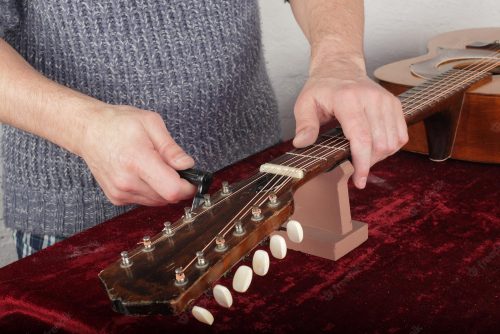
You might need $800 to $1200 to get it fixed
A professional will normally charge between $800 and $1,200 to fix a warped guitar neck. It could be impossible to tune your guitar in some places if the neck is warped. Your neck needs to be straightened for the guitar to sound good.
Thankfully, you have the option of doing your own guitar neck repair. But for severe or intense warp, you might need to make use of the luthier’s service next to you.
Also Read: Intonating Guitar 101: Cost, When & How Often To Do It (+FAQ)
How Do You Tell If a Guitar is Warped?
When one side of the guitar neck is lower than the other, the guitar neck is said to be warped. If the frets appear to be winding up like a staircase rather than being evenly bent from one side of the neck to the other, the neck is likely warped.
Another indication of neck warping is If there is a discernible difference in the guitar’s motion from string to string. And an irregular space between the strings, more noticeable in the higher strings than the lower ones.
However, these techniques can be used to accurately determine whether a guitar is warped. They are;
1. Eyeball Method

Eye balling guitar warped neck
To carry this method out, grab your guitar and look down the neck from the top of the headstock or from the bottom of the guitar up to the headstock to check if the neck is bent and not scalloped. If the neck is warped, it will resemble a narrow stairway.
Without a doubt, this is the method used the most frequently to determine whether a guitar neck is warped or not. The guitar neck should have some inward curve (also known as concave), but never any outward curve (convex).
2. Feeler Gauge Method
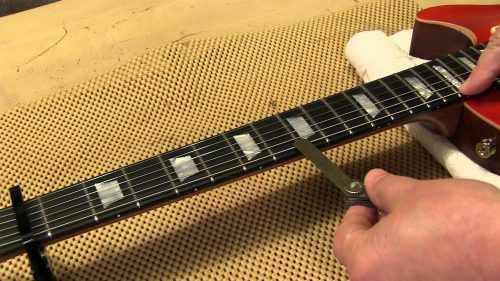
Using a feeler gauge is a far better method of determining whether or not your guitar neck is warped. A typical amount of relief, or concave curvature, on an electric guitar is about 0.010′′ or 254mm.
While putting a straightedge or ruler up to the frets of the fretboard as a measuring tool for comparison, you would take the feeler gauge and insert it underneath the string on top of each fret across various regions of the guitar neck.
You can also use a feeler gauge to measure the neck warp by holding down the low-E string at the 7th and 15th frets, placing the gauge underneath that spot, and measuring the distance from the string to the 12th fret. Apply the same technique to the high-E string on the opposite side of the instrument.
One measurement is taken on the high-E string side, and the other is taken on the low-E string side. It’s normal for there to be a small difference between the two measurements, but if the difference is too great, this could indicate an unnatural twist or a guitar warp.
FAQs
Q: Does Hanging Guitar Damage Neck?
Not at all. The neck of a guitar is not harmed in any way when it is hung on a wall. The force exerted on the neck by the strings while they are under tension is far more than the force of gravity.
Fortunately, while your guitar is hanging, the neck (and wood in general) can withstand the weight and pressure. A guitar can withstand tensile forces equal to its weight. That would typically be around 10 pounds, which is within the elastic limit of the wood.
Therefore, there are few opportunities for elongation, and if it does happen, it would return soon once the force is gone. Generally, I would say that hanging your guitar for a long time wouldn’t cause any noticeable structural changes.
But then, although hanging the guitar won’t harm the neck, it occasionally can harm the finish. When they contact the back of the guitar neck, certain rubber and foam-based guitar hangers may damage the finish. For this reason, picking the best guitar wall hanger is essential.
Also Read: Laying Guitar Flat: Is It Bad? (Vs Hanging & Lean On Wall)


